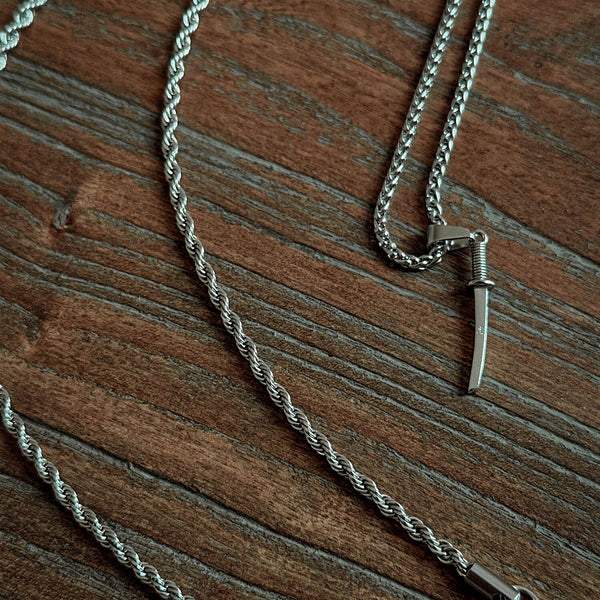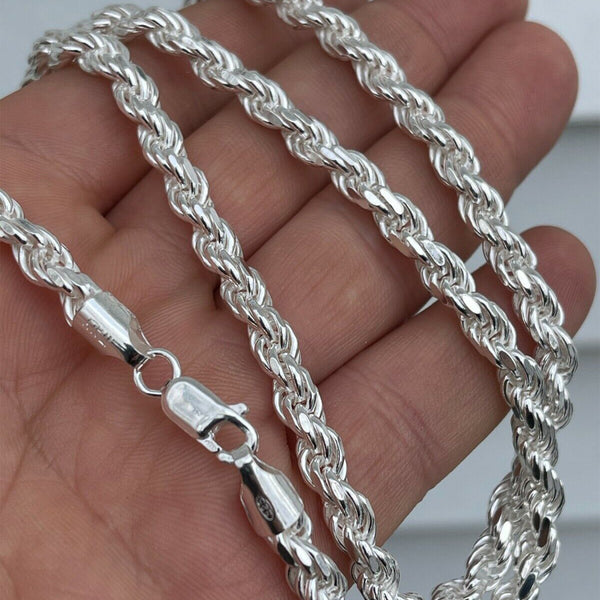When choosing jewellery, understanding the materials used to create it is key. Two common materials to make jewellery are stainless steel and sterling silver. Both of these metals offer their own set of characteristics.
In this blog, we compare stainless steel vs sterling silver jewellery. We’ll explore their pros and cons, and cover the differences between the two.
Stainless Steel Jewellery

Stainless steel jewellery refers to any piece of jewellery made with stainless steel. Stainless steel can have various chemical compositions.
One of the unique features of stainless steel is that it features chromium. This chromium forms a protective layer that stops oxidising and scratching.
Stainless steel has a darker more grey colour to it in comparison to white gold & platinum.
Pros
- Resistant to corrosion - this is because it features a chromium protective layer.
- Durable - stainless steel jewellery is durable, resistant to tarnishing, rusting and corrosion.
- Scratch-resistant - stainless steel jewellery doesn’t scratch as easily as other metals. It is naturally a harder material.
- Affordable - stainless steel is not a rare or precious metal. This makes it a great choice for those on a budget.
- Low maintenance - it is easy to clean stainless steel. Just use a soft cloth and a bit of liquid detergent.
- Hypoallergenic - stainless steel is a low carbon, high chromium alloy. This makes it hypoallergenic and suitable for sensitive skin.
- Environmentally friendly - stainless steel jewellery is 100% recyclable.
Cons
- Harder to repair - Stainless steel jewellery if damaged is difficult to repair. This is because it is less malleable.
- Has a darker appearance - stainless steel is less shiny and is darker in appearance.
- Value - stainless steel jewellery has no resale value. Stainless steel as a metal is not precious.
Sterling Silver Jewellery

Sterling silver jewellery refers to any piece of jewellery that is made from silver. Sterling silver jewellery is normally composed of 92.5% pure silver and a 7.5% copper alloy. Sterling silver jewellery is often alloyed with other metals to increase it's durability. These metals include copper, zinc and even platinum.
Sterling silver isn’t as rare as gold and platinum, however, it is still considered a precious metal. Jewellery made from 92.5% silver will have a hallmark to indicate their composition.
This is a popular choice of material for jewellery as it offers a silver lustre like no other. It also offers a brighter more white appearance.
Pros
- Affordable - Sterling silver is a precious metal, but still much more affordable than gold and platinum. This is because sterling silver is not as rare as metal.
- Can create more intricate designs - Sterling silver is a more malleable metal. Jewellery made from silver can be more intricate and complex.
- Can be adjusted - Sterling silver is a malleable material. Jewellery made from silver can be easily adjusted.
- Easy to repair - Sterling silver is a softer metal and can easily be fixed with basic soldering.
- Has greater lustre - naturally, sterling silver has a great white lustre.
- Higher value - Sterling silver is a precious metal. Therefore jewellery made from sterling silver has a higher value.
Cons
- More prone to damage - Sterling silver jewellery is much more prone to scratching, dents and damage
- More prone to tarnishing - Sterling silver jewellery does not have chromium. This means it is susceptible to tarnishing and fading.
- Less hypoallergenic - Sterling silver jewellery is less hypoallergenic. This is because it contains nickel or copper alloys. This can be irritating for people with sensitive skin.
- More expensive than stainless steel - Sterling silver jewellery is much more expensive than stainless steel. This is because silver is a precious metal.
- Less environmentally friendly - Sterling silver jewellery can’t be recycled like other types of metals. The production process for sterling silver jewellery is also much more pollutant to the environment.
- High maintenance - Sterling silver jewellery requires regular cleaning and polishing to maintain it's appearance. Jewellery made from sterling silver is much more susceptible to tarnishing and corroding.
What Is The Difference Between Stainless Steel And Sterling Silver?
- Composition - stainless steel consists of iron and carbon, with the addition of chromium & nickel. 925 sterling silver consists of 92.5% silver and 7.5% of other metals usually copper or zinc.
- Durability & maintenance - stainless steel offers greater durability than sterling silver jewellery. Stainless steel is a harder material and is corrosion and scratch-resistant.
- Appearance - sterling silver has a bright white lustre that gives off a much more luxurious feel. Stainless steel is more of a grey colour and is less shiny.
- Hypoallergenic properties - stainless steel is more hypoallergenic than sterling silver. This is because stainless steel has minimal nickel and copper content. The alloys in sterling silver can cause skin allergies for some.
- Cost - sterling silver jewellery is more expensive than stainless steel jewellery. This is because sterling silver is a precious metal. The craftsmanship and labour required to turn it into jewellery is much great than with stainless steel.
- Design - sterling silver can be used to create a more intricate and detailed design as it is softer. Whilst stainless steel is harder and less malleable.
- Value - sterling silver is a precious metal and therefore has a higher value than stainless steel.
- Environmental Impact - stainless steel is more environmentally friendly material than sterling silver. This is because stainless steel is 100% recyclable.
Stainless Steel Jewellery vs Sterling Silver: Which One Is Best For You?
Whether stainless steel or sterling silver jewellery will be better for you will depend on your budget & personal preferences.
Stainless steel jewellery is the perfect choice for someone on a budget who is looking for long-lasting, durable and hypoallergenic jewellery. Whilst sterling silver jewellery is ideal for those who want a truly shiny chain that has actual value and can be much more intricate in design.
Conclusion
After reading our blog that compared stainless steel jewellery vs sterling silver jewellery, you should have a better understanding of both types of jewellery. You should also be more aware of the pros, cons and differences of both.
Stainless steel jewellery offers great affordability, durability and hypoallergenic properties, however lacks value. Whilst sterling silver offers great lustre, has value, and can be easily fixed, however is much more expensive and delicate.
Both these types of jewellery have their pros and cons. At the end of the day you should choose the type of jewellery that you feel most comfortable styling with. As well as the one that you like the look of the most!
Looking to find out more about stainless steel jewellery? Check out our ultimate guide to stainless steel jewellery here.
FAQ’s About Stainless Steel And Sterling Silver JewelleryIs stainless steel jewellery worth buying?Yes, stainless steel jewellery is worth buying. Stainless steel is affordable, durable, tarnish and corrosion resistant. It is the perfect material for everyday wear jewellery pieces. Is stainless steel or sterling silver better for sensitive ears?For those with sensitive ears, stainless steel would be the better choice. Stainless steel is more hypoallergenic than sterling silver. This is due to the presence of chromium. Which lasts longer, sterling silver or stainless steel?In general, stainless steel will last longer than sterling silver. Stainless steel is a harder material, is durable and scratch resistant and won’t tarnish when exposed to moisture and oxygen. |












































